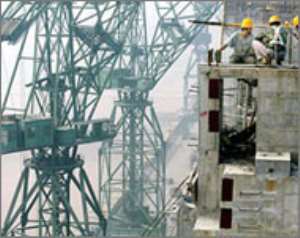
Construction is set to finish next week on the world's largest hydropower project, but its critics say that the lessons about its environmental consequences are yet to be learned.
With the last of the concrete being poured nearly a decade after China stemmed the flow of the Yangtze river to begin work, environmentalists say the Three Gorges Dam should provide a cautionary tale to an energy-hungry government pushing similar hydropower dam projects.
China says the Three Gorges will have a generating capacity of 18GW (gigawatts) of power when it is complete in 2009. It will also reduce flooding on the Yangtze, fuel industrial growth and improve shipping.
About 300,000 people have died in the 20th century due to the river flooding.
"If we look at the four purposes, only the first has been realised - it can produce power," said Dai Qing, China's most outspoken opponent of the Three Gorges.
"But compared to other methods of generating power, that electricity is much more expensive," she said.
The dam started generating power in mid-2003 and will have 26 turbines when it reaches full capacity in 2009.
The dam's price tag, estimated at $10.8 billion in 1993, is expected to reach $25 billion when completed.
Costs of power
How the costs of the power that the Three Gorges Dam generates are calculated is no academic question.
It cuts to the heart of the compromises facing China, which relies on sulphur-belching coal for about 70% of its energy, as it seeks less polluting but affordable sources of power to fuel an economic growth of more than 10% a year.
On construction costs alone, analysts say Three Gorges power is competitively priced.
But its critics argue that with the need to resettle about 1.3 million people flooded out of their homes, and environmental impacts of erosion, sediment build-up and the tonnes of sewage flowing into the dam's reservoir each year, the true costs are much higher.
And with China's total generating capacity about 508GW by the end of 2005 and another 75GW to be added this year, the dam's 18GW will not have the same impact it would have when the project was approved in 1992.
"When it was approved, nobody in their right mind would have thought that China would be adding the equivalent of the capacity of the whole of the UK in one year," said Joseph Jacobelli, an analyst at Merrill Lynch in Hong Kong.
"Any additional capacity helps, but in the global scheme of things the Three Gorges is quite small."
With the end of the project that in sight, critics say opposition is still relevant because of the effect on future dam-building.
Raging debate
More than a dozen hydropower projects for the upper reaches of the Yangtze have been proposed, including one to dam the Tiger Leaping Gorge, a tourist paradise in the Tibetan foothills of China's southwestern province of Yunnan.
There is also debate over plans to harness Yunnan's Nu river with a chain of up to 13 hydropower stations, a project that would take a decade to build and generate more power than the Three Gorges.
Since the Three Gorges was approved, there is now environmental impact legislation in China, but critics such as Dai Qing say the problem is that there is a lack of public participation and open debate about such massive projects.
Environmental impact studies of the Nu river proposal have been done, but not publicly released.
"I think the government can really only proceed with more dams if they can maintain a fiction that Three Gorges makes sense," said Patricia Adams, executive-director of Probe International, a Canadian environmental think-tank.
"There are better methods of electricity production being locked out in order to protect a bigger project like the Three Gorges."




 Lay KPMG audit report on SML-GRA contract before Parliament – Isaac Adongo tells...
Lay KPMG audit report on SML-GRA contract before Parliament – Isaac Adongo tells...
 Supervisor remanded for stabbing businessman with broken bottle and screwdriver
Supervisor remanded for stabbing businessman with broken bottle and screwdriver
 NDC watching EC and NPP closely on Returning Officer recruitment — Omane Boamah
NDC watching EC and NPP closely on Returning Officer recruitment — Omane Boamah
 Your decision to contest for president again is pathetic – Annoh-Dompreh blasts ...
Your decision to contest for president again is pathetic – Annoh-Dompreh blasts ...
 Election 2024: Security agencies ready to keep peace and secure the country — IG...
Election 2024: Security agencies ready to keep peace and secure the country — IG...
 People no longer place value in public basic schools; new uniforms, painting wil...
People no longer place value in public basic schools; new uniforms, painting wil...
 'Comedian' Paul Adom Otchere needs help – Sulemana Braimah
'Comedian' Paul Adom Otchere needs help – Sulemana Braimah
 Ejisu by-election: Only 33% of voters can be swayed by inducement — Global InfoA...
Ejisu by-election: Only 33% of voters can be swayed by inducement — Global InfoA...
 Minority will expose the beneficial owners of SML, recover funds paid to company...
Minority will expose the beneficial owners of SML, recover funds paid to company...
 Prof. Opoku-Agyemang has ‘decapitated’ the NPP’s strategies; don’t take them ser...
Prof. Opoku-Agyemang has ‘decapitated’ the NPP’s strategies; don’t take them ser...
